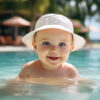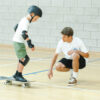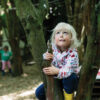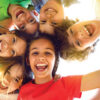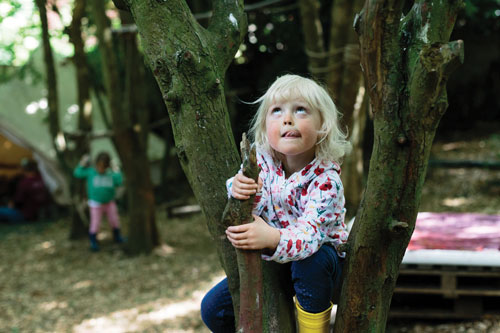
by Lucy Owen-Collins
Head of Adventures at Bee in the Woods
The powerful benefits of outdoor risky play
In an age of screen time, padded playgrounds and hyper-awareness of safety, it can feel instinctive to shout “Be careful!” every time your child climbs a tree or scrambles up a boulder. But what if, in our effort to protect, we’re holding our children back?
As parents, we want to keep our children safe, but research shows that too much caution can actually hold children back from vital developmental opportunities.
Risky play; those thrilling, uncertain, physical experiences like climbing, jumping from heights, balancing on logs, or exploring wild spaces – is more than just a childhood rite of passage. It’s a crucial ingredient in how children grow into confident, capable, resilient adults.
Author and childhood play advocate Tim Gill, in ‘No Fear: Growing Up in a Risk Averse Society’, argues that children need real opportunities to test their limits and take measured risks. When we support rather than suppress this kind of play, we empower children to become more aware of their bodies, make better decisions and develop lifelong emotional resilience.
The benefits of risky play
Physically, risky play helps children build strength, agility, coordination and fine motor control. Scrambling up a climbing frame, balancing on a log, or running across sand not only keeps children active – it enhances their core stability, posture and endurance.
Sensory development also thrives in outdoor play. Movements like spinning, swinging, rolling and balancing stimulate the vestibular and proprioceptive systems – key components in helping children understand where their body is in space. These experiences lay the foundation for everything from focus and attention to emotional regulation and coordination.
Cognitively, risky play sharpens problem-solving and decision-making. Children must assess their environment – “Is this branch strong enough? Can I jump that far?” – and adjust their approach in real time. This self-assessment builds independence and executive function.
Socially and emotionally, children learn to regulate emotions like fear and frustration, and to persevere after a fall or failure. When playing with others, they negotiate, take turns, lead and follow – all vital skills for life. Risky play also nurtures courage and self-esteem: there’s nothing like the glow of pride after scaling a tall rock or swinging across a stream.
Risk is not the enemy – danger is
There’s a difference between risk and danger. Risk is a challenge a child can see, consider and try to overcome. Danger is something hidden or poorly understood. As adults, our role is to assess the environment, offer guidance and stay nearby, rather than removing every possible hazard or stepping in too soon.
Forest School Leaders often use a ‘risk-benefit’ approach – recognising that the benefits of play with risk often outweigh the downsides when managed sensibly.
Supporting safe risky play: What parents can do
Instead of shutting down adventurous play, we can shift how we support it. Here are a few ways parents can help children assess risk:
• Talk it through: Ask, “What’s your plan?”, “How could you do that safely?” or “What’s your next step?” These questions should help children think critically and prepare.
• Model curiosity, not fear: Stay calm and positive, even when your instincts are shouting. You can always move closer or spot from a distance.
• Celebrate effort, not just achievement: Say, “You tried that really carefully” or “I noticed how you tested that first”, to reinforce thoughtful behaviour.
• Know your child: Every child has a different threshold for risk. Trust their instincts, but be there to encourage and, occasionally, challenge them.
What to say instead of “Be careful”
“Be careful” is vague and often ineffective. Try these alternatives:
• “Can you find a steady place for your feet?”
• “Use both hands.”
• “Take your time and notice what’s around you.”
• “What’s your plan if that wobbles?”
• “I’m right here if you need me.”
These phrases promote awareness, decision-making and reassurance without instilling fear.
Risky play in different environments: Safety tips
Outdoor environments offer rich, natural opportunities for risky play. Here’s how to support children’s exploration safely and confidently in a few common settings:
At the beach
• Water safety first: Teach children to respect the tide, watch the sea and stay within view. Watch for strong currents and always stay close when water is involved.
• Digging and climbing: Sand dunes and rock pools offer exciting climbing opportunities. Encourage kids to test ground firmness and wear shoes with grip.
• Sensory-rich play: Let children roll, bury, balance, and run. Sand is a great medium for physical and imaginative play, but remind children not to dig too deep or tunnel near unstable edges.
In the woods
• Tree climbing: Don’t lift children into trees to climb them – encourage them to understand their own abilities by climbing themselves. Encourage kids to “climb down as well as up”- if they can’t get down safely, they’re too high. Avoid trees with dead branches and teach children keep ‘three points of contact’ on the tree at all times (two hands, one foot/one hand, two feet)
• Sticks and stones: Playing with natural materials builds creativity and coordination. Teach children how to carry sticks safely (point down, away from faces).
• Rough ground: Roots, mud and slopes are ideal for balance and proprioception. Wear shoes with grip and support falls as learning moments rather than failures.
On climbing equipment or rocks
• Let them fall small: Risky play doesn’t mean no bumps or bruises, but small falls teach children to adapt and try again.
• Check surfaces: Sand, bark chips or grass under climbing equipment help cushion falls. Encourage safe jumping and always remind children to look before leaping.
Why it all matters
When we give children permission to play with risk, we do more than help them become physically stronger. We show them that we trust their judgment, believe in their resilience and honour their growing independence.
Let’s raise children who aren’t afraid to fall, try again and learn through doing. The outdoors is their natural training ground. So next time your child teeters on a tree limb or builds a fort from branches, take a breath and remember: this is childhood, exactly as it should be.
Bee in the Woods Kindergarten is a woodland preschool and community Forest School for three to seven year olds, based in Portslade and Stanmer Park in Brighton.
For more information www.beeinthewoods.co.uk


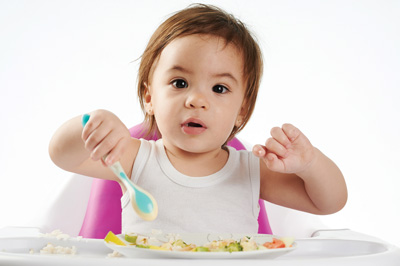
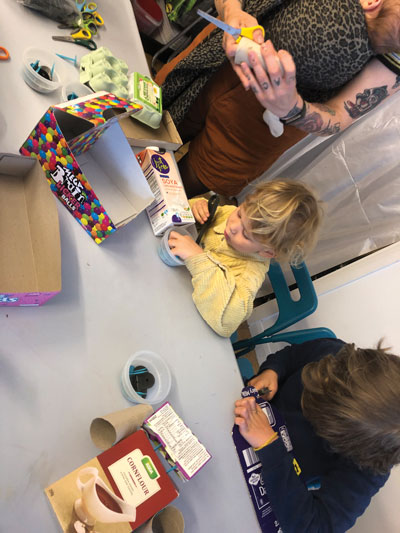

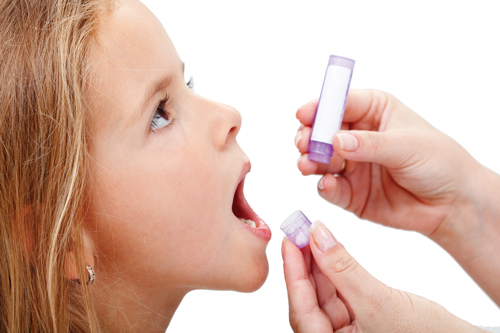


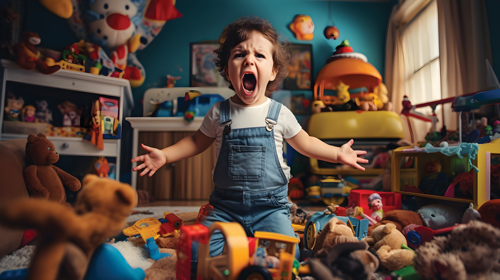
 isten when their siblings say no to them entering their room. Emphasising that we also want to respect other people’s boundaries and giving them the language around boundaries is also really helpful. A boundary might not always sound like the word “no”, it can be “That doesn’t work for me”, or “I don’t like the sound of that,” and when you understand that this is someone conveying their boundaries, not only do they have phrases to listen out for but they have the same phrases they can use themselves.
isten when their siblings say no to them entering their room. Emphasising that we also want to respect other people’s boundaries and giving them the language around boundaries is also really helpful. A boundary might not always sound like the word “no”, it can be “That doesn’t work for me”, or “I don’t like the sound of that,” and when you understand that this is someone conveying their boundaries, not only do they have phrases to listen out for but they have the same phrases they can use themselves.

